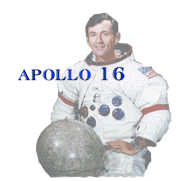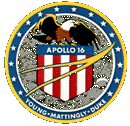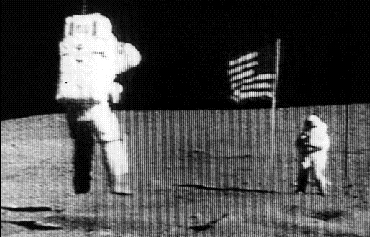
|

|
This page last updated |

|

|
This page last updated |

|
Apollo 16
AS-511
|
| 1 | 2 | 3 | 4 | 5 | 6 | 7 | 8 | 9 | 10 | 11 | 12 | 13 | 14 | |
| 15 | 16 | 17 | 18 | 19 | 20 | 21 | 22 | 23 | 24 | 25 | 26 | 27 | 28 | |
| 29 | 30 | 31 | 32 | 33 | 34 | 35 | 36 | 37 | 38 | 39 | 40 | 41 | 42 | Links |

Apollo 16 home after busy trip
Johnson Space Center Space News Roundup - May 9, 1997
[Edited from the Space News Roundup April 28, 1970.]NASA Photo S72-35610
Young sets up the lunar portable magnetometer during the first of three lunar extravehicular activities.
Despite being cut one day short, Apollo 16 ended as gloriously as it started. Its legacy is a wealth of scientific data that will tell man more about his very beginnings, perhaps something about his future. Astronauts John Young, Thomas Mattingly and Charles Duke accomplished almost everything they set out to do even though they lost about 24 hours from their flight plan. The change in schedule was made in deference to a potentially faulty thrust vector control system on the service propulsion engine the rocket needed for the trip home. Because he experienced oscillations in the engine as he checked it out, Mattingly called off the burn that would circularize his orbit at about 70 miles. While he worked alone in the command module Casper, Young and Duke lent moral support in the separated lunar module Orion. The go for landing came almost six hours late, but the touchdown on the dusty, block-strewn Descartes was perfect. Old Orion is finally here, Houston. Duke exclaimed at 8:23 p.m. CST April 20. The journey to Descartes started more than four days earlier. Liftoff from Pad A at the Kennedy Space Center in Florida was right on time - 11:54 a.m. Sunday April 16, 1972. A little more than two and a half hours later, the crew performed the translunar injection burn that headed them toward the moon. Paint flaking from the ascent stage of Orion, a lockup in Casperís navigation system and a balky steerable antenna on Orion were other pesky difficulties encountered before landing, but they proved far less worrisome than the thrust vector control situation. But, once on the surface, Young and Duke turned their attention to exploration. The first extravehicular activity, during which the lunar roving vehicle was assembled, the Apollo lunar surface experiments package (ALSEP) deployed, the U.S. flag raised and the solar wind composition experiments erected, lasted 7 hours and 11 minutes.
The rover logged 4.2 kilometers of lunar travel, and the explorers collected 41 pounds of rock and dust samples. EVA Two lasted 12 minutes longer than the first, and sample weight was exactly double. Rover travel was 11.5 kilometers. Young picked up a rock and made Earth-bound scientists perk up with This is the first one Iíve seen I really believe is crystalline. The pair also scooped up a special sample from under a lunar boulder. The third and final surface exploration was the shortest - 5 hours and 40 minutes - but perhaps the most spectacular. When they reached North Ray Crater, Young and Duke found it an awesome sight, three-quarters of a mile across and more than 200 yards deep, the general vicinity spotted with massive boulders. Collected samples weighed about 90 pounds, bringing the three-day total to 212-214. Distance covered in the rover totaled 27.1 kilometers, about 16.8 miles. And time on the three EVAs added up to 20 hours 14 minutes. Mattingly was equally busy with his mapping. After lunar liftoff, televised by the remotely controlled camera on the rover, and rendezvous and docking with the command module, Mattingly reported that morale around here just went up a couple hundred percent. Apparently the thrust vector control problem had not been forgotten. Apollo 16 headed home at 8:27 Monday evening. When the craft rounded the moon and radio contact was reestablished, Orion was turned loose. It immediately started a slow tumbling. The trouble was an improperly positioned circuit breaker. Without attitude control, the LM ascent stage could not be impacted onto the moon as planned. It is expected to fall from orbit on its own in about 200 days. The subsatellite, with its scientific equipment, was injected into lunar orbit, but no radio contact could be made with it since its frequency was the same as the lunar module. On the homeward leg, Mattingly got his own chance to conduct an EVA. He spent a bit more than an hour outside, retrieving film from the scientific instrument module and activating the microbial response experiment. With splashdown in the Pacific some 175 miles southeast of Christmas Island, Apollo 16 became history. Only one manned flight to the moon remains on the schedule.

NASA Photo S72-35611
Casperís passengers were as happy to get home as Jumping Jack Young was to get to the Moon.
|
|
| 1 | 2 | 3 | 4 | 5 | 6 | 7 | 8 | 9 | 10 | 11 | 12 | 13 | 14 | 15 | 16 | 17 | 18 | 19 | 20 | 21 | |
| 22 | 23 | 24 | 25 | 26 | 27 | 28 | 29 | 30 | 31 | 32 | 33 | 34 | 35 | 36 | 37 | 38 | 39 | 40 | 41 | 42 | Links |
Home Biography Missions Appearances Bibliography Site Map Critique this site! Other Astros
John W. Young - American & International Hero Title Page
Page created by Dana Holland - webmaster @ johnwyoung.org
Dana's Page
This site is for informational and educational purposes only. It is NOT sanctioned by John Young, NASA, or Navarro College.